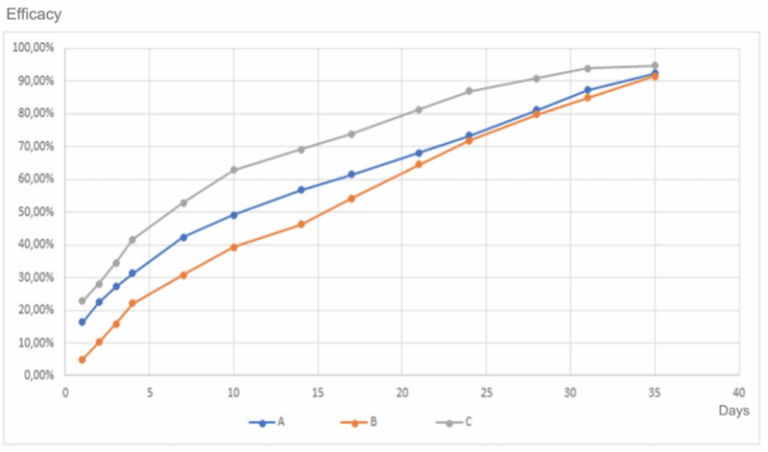 by Véto-pharma
by Véto-pharma Apivar 2.0: Quicker action against varroa mites, with less amitraz? You’re probably wondering how we achieved that. Well, this was precisely the purpose of the reformulation our R&D team worked on. It took us several years to reach the desired outcome, and we are very proud to present the result today, to help make your varroa mite treatments more efficient.
The earlier formulation of Apivar contained 3.33% amitraz, whereas Apivar 2.0 includes only 3.00%. However, this decrease does not make the product any less effective. In fact, thanks to the dedicated work of our R&D team in developing Apivar 2.0 (and also Amiflex®), the release of amitraz in these updated formulations has been accelerated without raising the overall dosage. This improvement was accomplished by refining the blend of other materials (carriers) used in the treatment. Apivar 2.0 was specifically engineered to deliver a more efficient release of the active ingredient, especially during the initial weeks of application.
Definition of “Active ingredient”: It’s the main ingredient in the formulation (often called the “molecule”) that has an effect on varroa mites. Other ingredients are called “excipients” (= inactive ingredients) and are included in the formulation to enhance the release or improve stability, for example. For instance, the active ingredient of Apivar, Apivar 2.0, and Amiflex is amitraz.
As explained in our previous article “Same concentration, different outcome: understanding variability in varroa mite treatments”, the percentage of active ingredient alone is not an accurate predictor of treatment efficacy. Simply boosting the concentration isn’t a silver bullet, and we should definitely not enter that race. Increasing the dosage of the active ingredient per hive would not be a sustainable approach. On the contrary, it could lead to increased residues in wax and other hive products – which in turn could promote resistance development in varroa mite populations when they are continuously exposed to residues in their environment.
So, which aspect of a new treatment formulation does affect field efficacy? One of the most significant factors that most people do not necessarily have in mind at first is the “galenic formulation,” also known as how the active ingredient is released into the hive. The galenic formulation takes into account all the ingredients in the product and the form of application (strip, liquid, gel, powder, etc.).
As explained in the previously mentioned blog post, two different formulations with the same concentration of active ingredient can deliver very different efficacy results against varroa mites.

In this graph, you can see three different acaricide strips based on the same active ingredient, with the exact same dosage. What’s the only change? The formulation of the strips. You can clearly see faster reduction of the mite infestation in strip C compared to strip A.
Spoiler alert: Strip C is Apivar 2.0. Strip A is the original Apivar. All of that with less amitraz. Nice, isn’t it?
Of course, we do not select any additional ingredient at random without testing its effect on bees. The goal when working on a new formulation is always to include a minimum number of additional ingredients, keeping only those that are strictly necessary. The original Apivar was composed of two ingredients: amitraz and the plastic of the strip. With Apivar 2.0, you have only four ingredients in total, including amitraz. This is not much compared to other treatments that contain up to nine different ingredients in some cases.
These extra components have been deliberately chosen to enable the controlled release of amitraz and to improve its stability over time. Each has been extensively assessed and authorized for use in honey bee colonies. Moreover, the final formulation has been subjected to strict testing to confirm that it is safe for colonies and does not leave any harmful residues inside the hive. We also prioritize formulations that help minimize beekeepers’ exposure to the active substance.
This is the kind of work we are doing in our R&D lab and research apiary: testing formulations that deliver better results without increasing the dose of active ingredient (because residue levels matter to us) and ensuring that the entire formulation will not harm the bee colonies.
This is why we don’t only focus on identifying new molecules against varroa mites—because there is also room to improve already-known active ingredients, to provide improved efficacy, fewer side effects, or easier forms of application (for instance, what we did with Amiflex®, offering a ready-to-use flash amitraz treatment for commercial beekeepers).
—-
The road is long and paved with challenges, but definitely worthwhile. Our mission is to increase the number of tools in your beekeeper’s toolbox, to reduce the constraints involved in using mite treatments (fewer applications, no temperature limitations, etc.), and to provide you with the support you need to make your work easier. The battle against varroa mites is not getting any easier—it is our role to bring you new solutions, and your role to adopt an IPM strategy against varroa mites to preserve the effectiveness of the active ingredients available. It is time to think long term and refrain from taking any shortcuts that could compromise the effectiveness of our existing arsenal against the mite.
 by Véto-pharma
by Véto-pharma  by Caroline Lantuejoul
by Caroline Lantuejoul